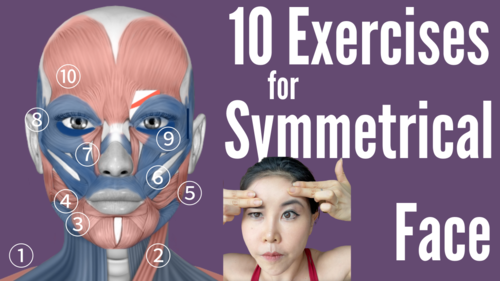I am here to share with you a set of 10 facial exercises that can help you achieve a more symmetrical face. Facial symmetry is often considered a sign of attractiveness, and these exercises can assist in improving the balance and proportion of your facial features.
1. Side neck
As we commence with the first exercise, I would like to advise you that if you are currently experiencing neck pain, it is best to refrain from this exercise or proceed with caution. It is common for one side of the face to be tighter or looser than the other. In such cases, we suggest beginning with the tighter side and avoiding any abrupt or forceful movements. Instead, gradually and gently apply pressure to the area. Hold this position for five seconds, and then switch to the other side for an equal duration. Finally, complete the exercise by returning to the tighter side for another five seconds of gentle stretching. Remember to listen to your body and avoid overexertion.
2. SCM
Sternocleidomastoid (SCM) muscle. First, identify which side is stronger for you. In my case, it's this one. Once you have identified the stronger side, tilt your head at a 45-degree angle and look upwards while performing a big stretch. Stick out your tongue and close your eyes if you wish to do so. Then, relax your muscles for five seconds before slowly returning to your starting position.
Repeat this exercise by tilting your head at a 45-degree angle, looking up, and stretching while sticking out your tongue. Remember to focus on the tighter side and perform the exercise in a slow and controlled manner. Once you have completed the exercise on the tighter side, gently release any tension in your neck before moving on to the next exercise.
3.Masseter
The masseter muscle is a powerful muscle located in the jaw that is responsible for chewing and biting. It connects the cheekbone to the lower jawbone and plays a vital role in the movement of the jaw during mastication. Overuse or tension in the masseter muscle can lead to conditions such as bruxism (teeth grinding) and temporomandibular joint (TMJ) disorder.
4. DAO
The depressor anguli oris is a muscle located in the lower part of the face. It originates from the mandible (jawbone) and inserts into the corner of the mouth. The main function of this muscle is to pull down the corner of the mouth, causing a downward or sad expression. It is also involved in certain facial expressions such as frowning, pouting, and scowling. Dysfunction or weakness in the depressor anguli oris can result in facial asymmetry or difficulty in producing certain facial expressions.
5. Risorious
The risorius is a thin, narrow muscle located in the cheek area of the face. It originates from the fascia surrounding the masseter muscle and inserts into the corner of the mouth. The primary function of this muscle is to pull the corner of the mouth laterally, which can create a smile-like expression. The risorius muscle is activated when laughing or smiling and is involved in expressing happiness or joy. Dysfunction or weakness in the risorius muscle can result in difficulty in producing certain facial expressions, particularly those involving smiling or laughing.
6. Zygomaticus
The zygomaticus is a facial muscle that originates from the cheekbone (zygomatic bone) and extends to the corner of the mouth. There are two zygomaticus muscles on each side of the face, and their primary function is to lift and retract the corner of the mouth, creating a smile. These muscles are activated when laughing or expressing happiness, and they play a crucial role in nonverbal communication. Dysfunction or weakness in the zygomaticus muscles can result in difficulty in producing a smile or facial expressions involving the mouth.
7. LAO
The levator anguli oris muscle is a facial muscle that originates from the maxilla bone in the upper jaw and inserts into the corner of the mouth. The primary function of this muscle is to lift the corner of the mouth, creating a smile like expression. The levator anguli oris muscle is activated when laughing, smiling, or expressing happiness and plays an essential role in nonverbal communication. Dysfunction or weakness in the levator anguli oris muscle can result in difficulty in producing certain facial expressions or an asymmetrical smile.
8. Malaris
The malaris muscle is a small facial muscle located in the cheek area. It is sometimes also called the zygomaticus minor muscle, as it is located near the zygomatic bone. The malaris muscle originates from the zygomatic bone and inserts into the skin around the corner of the mouth. Its function is to elevate the upper lip and pull the corner of the mouth upward, producing a smile like expression. The malaris muscle is activated when laughing or expressing happiness and plays a role in nonverbal communication.
9. Obercularis Oris
The orbicularis oris muscle is a circular muscle that surrounds the mouth and is responsible for closing and protruding the lips. It is one of the primary muscles involved in facial expression and plays an important role in speech and eating. The orbicularis oris muscle is composed of several muscle fibers that originate from the maxilla bone in the upper jaw and the mandible bone in the lower jaw, and they insert into the skin around the mouth.
10. Frontalis
The frontalis muscle is a thin, broad muscle located in the forehead region of the face. It originates from the galea aponeurotica, which is a tough fibrous sheet of tissue covering the top of the skull, and inserts into the skin of the eyebrows and upper eyelids. The frontalis muscle is responsible for elevating the eyebrows and creating horizontal wrinkles across the forehead when contracting.

